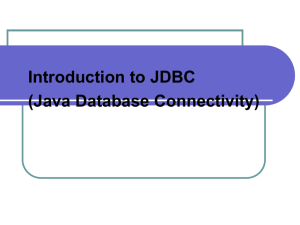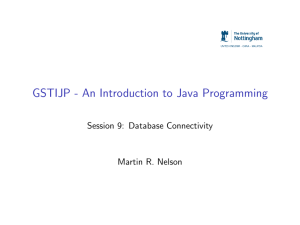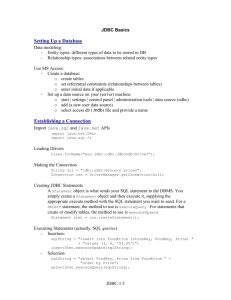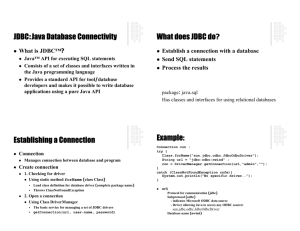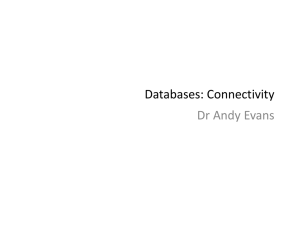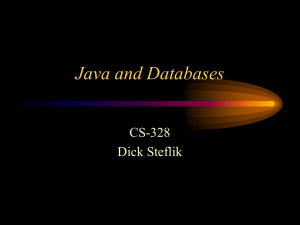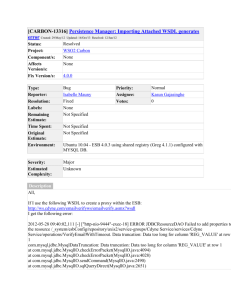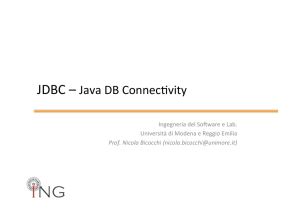A JDBC Example
advertisement
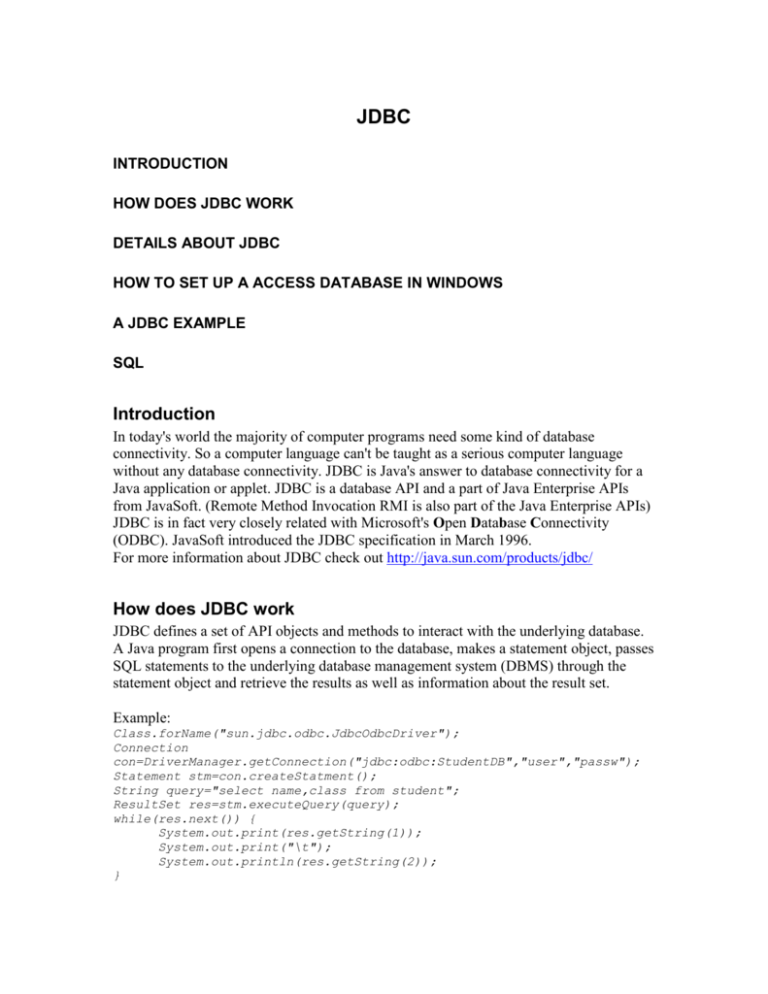
JDBC
INTRODUCTION
HOW DOES JDBC WORK
DETAILS ABOUT JDBC
HOW TO SET UP A ACCESS DATABASE IN WINDOWS
A JDBC EXAMPLE
SQL
Introduction
In today's world the majority of computer programs need some kind of database
connectivity. So a computer language can't be taught as a serious computer language
without any database connectivity. JDBC is Java's answer to database connectivity for a
Java application or applet. JDBC is a database API and a part of Java Enterprise APIs
from JavaSoft. (Remote Method Invocation RMI is also part of the Java Enterprise APIs)
JDBC is in fact very closely related with Microsoft's Open Database Connectivity
(ODBC). JavaSoft introduced the JDBC specification in March 1996.
For more information about JDBC check out http://java.sun.com/products/jdbc/
How does JDBC work
JDBC defines a set of API objects and methods to interact with the underlying database.
A Java program first opens a connection to the database, makes a statement object, passes
SQL statements to the underlying database management system (DBMS) through the
statement object and retrieve the results as well as information about the result set.
Example:
Class.forName("sun.jdbc.odbc.JdbcOdbcDriver");
Connection
con=DriverManager.getConnection("jdbc:odbc:StudentDB","user","passw");
Statement stm=con.createStatment();
String query="select name,class from student";
ResultSet res=stm.executeQuery(query);
while(res.next()) {
System.out.print(res.getString(1));
System.out.print("\t");
System.out.println(res.getString(2));
}
So the line Class.forName("sun.jdbc.odbc.JdbcOdbcDriver"); loads the JDBC
driver and register it with the DriverManager. The getConnection returns a Java
connection object, this methods first parameter is a database url. The url is of form
jdbc:<subprotocol>:<subname related to the DBMS/Protocol>. The getConnection
makes the connection using the driver registered to the subprotocol. Some subprotocol:
odbc the ODBC bridge
db2 the IBM DB2 database
So when you have the connection you can create statements, the connection can stay
open through the lifetime of an application. You get a Statement object by calling the
createStatment, from the connection object. Now when you have a statement object you
can make queries (SELECT) by calling executeQuery or executeUpdate, that execute a
SQL INSERT, UPDATE or DELETE statement. The executeQuery method returns a
ResultSet object that provides access to a table of data generated by executing a
Statement. You can loop trough all rows in the ResultSet with the next method, this
returns false when there is no more rows in the ResultSet. The most important thing with
statements and resultsets is that only one ResultSet per Statement can be open at any
point in time. Therefore, if the reading of one ResultSet is interleaved with the
reading of another, each must have been generated by different Statements. All statement
execute methods implicitly close a statment's current ResultSet if an open one exists.
Details about JDBC
The JDBC API is in the package java.sql it consists of 8 interfaces, 6 classes and 3
exceptions in JDK1.1.
Interfaces:
CallableStatement
Connection
DatabaseMetaData
Driver
PreparedStatement
ResultSet
ResultSetMetaData
Statement
Classes:
Date
DriverManager
DriverPropertyInfo
Time
Timestamp
Types
Exceptions:
DataTruncation
SQLException
SQLWarning
The most important ones are DriverManager, Connection, Statement, ResultSet.
The first thing is to register the JDBC driver with the DriverManager. The most common
way to do this is to load the class by the class name like
Class.forName("sun.jdbc.odbc.JdbcOdbcDriver"); this loads the JDBC-ODBC bridge
from JavaSoft and Intersolv. The JDBC-ODBC Bridge is part of the JDBC distribution.
This loads the IBM DB2 database application JDBC DRIVER:
Class.forName("COM.ibm.db2.jdbc.app.DB2Driver");
And this the IBM DB2 network JDBC DRIVER:
Class.forName("COM.ibm.db2.jdbc.net.DB2Driver");
As you see vendors can make different drivers depending how the applications will
communicate. The JDBC driver can also be in a native module, for windows the JDBCODBC bridge is in a native module named jdbcodbc.dll.
How to set up an Access database in windows
This will show you how to make a Java application using a Microsoft Access database.
Indeed Access is not a good database system but it's easy to use, widely spread in home
computers and cheap. If you make a real application, an application that is in commercial
use, I strongly suggest that you use some of the big database system like Oracle or DB2.
So start Access and choose a name for the database
Make the tables and columns with the GUI
Open the windows Control Panel and click the icon ODBC
Click the Add button
Choose the Microsoft Access driver and press Finnish
Click the Select button and browse to the database file you made
Give the database a name
(Optional) Click the Advance button and fill in a user name and password
Click Ok
That’s it
A JDBC Example
Here is simple database called simpledb. Simpledb have 3 tables named STUDENTS,
COURSES and RANKS. It looks like this:
STUDENTS
Studentnr (AutoNumber primary key)
Fname (text 50)
Lname (text 50)
Age (Integer)
Class (Integer)
COURSES
Coursenr (AutoNumber primary key)
Course (text 50)
Credit_units (Integer)
RANKS
Studentnr (Foreign key to STUDENTS.studentnr)
Coursenr (Foreign key to COURSES.coursenr)
Rank (Integer)
Then I made a JDBCTest applications that look like this:
You can fill in all details that JDBC needs to know, to work properly. The Driver name,
database url, username, password and make queries to the database.
The code:
import java.sql.*;
import java.awt.*;
public class JDBCTest extends Panel{
private TextField driver,database,user,pass,query;
private TextArea field;
private Connection con;
public static void main(String arr[]) {
Frame f=new Frame("JDBC Example");
JDBCTest test=new JDBCTest();
f.add(test);
f.pack();
f.show();
}
public void connect() {
try {
if(con!=null)
con.close();
con=DriverManager.getConnection(database.getText(),
user.getText(),
pass.getText() );
field.setText("Connected");
}catch (Exception e) {
field.append(e.toString());
System.err.println(e.toString());
e.printStackTrace(System.err);
}
}
public void register() {
try {
Class.forName(driver.getText());
field.setText("Registered");
} catch (Exception e) {
field.append(e.toString());
System.err.println(e.toString());
e.printStackTrace(System.err);
}
}
public boolean action(Event evt,Object what) {
if(evt.target instanceof Button) {
field.setText("");
if(what.toString().equals("Query")) { // do a select query
try {
Statement stm=con.createStatement();
ResultSet res=stm.executeQuery(query.getText());
ResultSetMetaData meta=res.getMetaData();
for(int i=1;i<=meta.getColumnCount();i++)
field.append(meta.getColumnName(i)+ "\t");
field.append("\n\n");
while(res.next()) {
for(int i=1;i<=meta.getColumnCount();i++)
field.append(res.getString(i)+ "\t");
field.append("\n");
}
res.close();
stm.close();
} catch (Exception e) {
field.append(e.toString());
System.err.println(e.toString());
e.printStackTrace(System.err);
}
}
else if(what.toString().equals("Update")) {
//do update,delete,insert query
try {
Statement stm=con.createStatement();
// the executeUpdate dosen't return a ResultatSet
int code=stm.executeUpdate(query.getText());
field.append("Ok");
stm.close();
} catch (Exception e) {
field.append(e.toString());
System.err.println(e.toString());
e.printStackTrace(System.err);
}
}
else if(what.toString().equals("Connect"))
connect();
else if(what.toString().equals("Update driver"))
register();
}
return true;
}
public JDBCTest() {
setLayout(new BorderLayout());
Panel top=new Panel();
top.setLayout( new GridLayout(4,1) );
Panel row=new Panel();
row.add(new Label("Driver:") );
driver=new TextField("sun.jdbc.odbc.JdbcOdbcDriver",50);
row.add(driver);
row.add(new Button("Update driver"));
top.add(row);
row=new Panel();
row.add(new Label("Database url:") );
database=new TextField(50);
row.add(database);
row.add(new Button("Connect"));
top.add(row);
row=new Panel();
row.add(new Label("user:") );
user=new TextField(50);
row.add(user);
top.add(row);
row=new Panel();
row.add(new Label("password:") );
pass=new TextField(50);
row.add(pass);
top.add(row);
Panel mid=new Panel();
mid.setLayout(new FlowLayout() );
mid.add(new Label("Query:") );
query=new TextField(100);
mid.add(query);
mid.add(new Label());
mid.add(new Button("Query"));
mid.add(new Button("Update"));
Panel bot=new Panel();
bot.setLayout(new FlowLayout() );
bot.add(new Label("Result:") );
field=new TextArea();
bot.add(field);
add(top,"North");
add(mid,"South");
add(bot,"Center");
}
}
So lets populate the database. The application automatically set the driver to
sun.jdbc.odbc.JdbcOdbcDriver. The database url looks like jdbc:odbc:simpledb.
If we write the sql statement insert into students (fname , lname , age , class) values
('Kalle' , 'Grönkvist' , 19 , 2) .If the transaction is successful the word Ok should appear
in the Result text area. Now if we write the statement select * from students the result
TextArea should show:
studentnr
fname lname age
class
1
Kalle Grönkvist
19
2
Consider we do these SQL statements:
insert into students (fname , lname , age , class) values (' Ville' , ' Johansson' , 20 , 3)
insert into students (fname , lname , age , class) values (' Johan' , ' Lindqvist' , 21 , 2)
insert into courses (Course , Credit_units) values ('Java Adv' , 2)
insert into courses (Course , Credit_units) values ('Java' , 2)
select * from students
studentnr
fname lname age
class
1
2
3
Kalle Grönkvist
Ville Johansson
Johan Lindqvist
19
20
21
2
3
2
select * from courses
Coursenr
Course Credit_units
1
2
Java Adv
Java 2
2
insert into ranks (studentnr , coursenr , rank) values (1,1,4)
insert into ranks (studentnr , coursenr , rank) values (1,2,5)
insert into ranks (studentnr , coursenr , rank) values (2,1,3)
insert into ranks (studentnr , coursenr , rank) values (2,2,3)
insert into ranks (studentnr , coursenr , rank) values (3,1,4)
insert into ranks (studentnr , coursenr , rank) values (3,2,4)
So what if we want to find out how Ville Johansson's result is in the Java Adv course?
Select lname,fname,course,rank from students S,courses C,ranks R where
lname='Johansson' and fname='Ville' and course='Java Adv' and
S.studentnr=R.studentnr and C.coursenr=R.coursenr
Result:
lname fname course rank
Johansson
Ville
Java Adv
3
SQL
Look in the text file SQLFAQ.txt for basic SQL.
